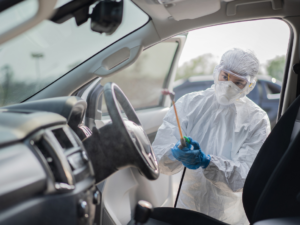AllAces Comprehensive Guide for Mould on Car Seats
AllAces Comprehensive Guide for Mould on Car Seats
Summary
The AllAces guide focuses on mould on car seats, its causes, removal methods, and prevention. Mould growth, mainly due to moisture, darkness, and warmth, can be harmful to health. Safe removal involves drying seats, vacuuming, using effective cleaning solutions like white vinegar, thorough cleaning, and ensuring complete drying. Leather seats may need conditioning post-cleaning. Preventing mould includes regular cleaning, addressing leaks, using moisture absorbers, wise parking, and routine ventilation. AllAces emphasises professional cleaning for optimal results.
Maintaining a vehicle involves more than just regular engine check-ups and oil changes. For many car owners, interior cleanliness, especially the seats, plays a vital role in ensuring a comfortable ride. One particularly pesky issue that car owners face is mould on car seats. The reasons can vary, but the solution is always imperative, both for aesthetic reasons and the health implications of mould.
Why Do Car Seats Get Mouldy?
Understanding the enemy is half the battle. Mould is a type of fungus, and like all fungi, it thrives in specific conditions:
Moisture: This is the primary catalyst. Be it a spill, wet clothes, or even high humidity, moisture is mould’s best friend.
Darkness: Parking in a dark garage or using car covers for prolonged periods can promote mould growth.
Warmth: Warm interiors, especially in the summer months, can accelerate mould growth.
Mould on Car Seats Removal Method
- Prioritize Safety: Always wear protective gloves and a mask. Mould spores, when airborne, can be inhaled, leading to respiratory issues.
- The Drying Process: Thoroughly drying the seats is paramount. Either park your car under direct sunlight or use fans. Ensure proper ventilation by keeping the doors and windows open.
- Vacuuming: Begin the mould removal process with a vacuum cleaner, especially with a HEPA filter, to remove loose mould spores and dirt. This step ensures a clean slate for the subsequent cleaning process.
- Selecting the Ideal Cleaning Solution: While several solutions can be employed for mould on car seats, here are the most effective ones:
- White Vinegar and Water: A natural disinfectant, white vinegar kills about 82% of mould species. Mix it in equal parts with water for a potent solution.
- Soap and Water: Sometimes, the simplest solutions are the most effective. Dish soap and water can dislodge mould colonies.
- Specialised Mould Removers: If you’re looking for a commercial solution, numerous products are designed explicitly for mould removal on car seats and vehicles.
- Rigorous Cleaning: Spray your chosen solution and let it sit for a few minutes. Using a scrubbing brush, gently yet firmly scrub the seats. For leather seats, be extra gentle to avoid scratches.
- Rinse and Repeat: After scrubbing, use a clean cloth to wipe off the residue. For soap-based solutions, a damp cloth will help rinse off any soapy remnants.
- Thorough Drying: This final step cannot be stressed enough; thorough drying is essential for effective mould on car seats removal. Any residual moisture can become the breeding ground for mould all over again.
- For Leather Seats: Conditioning Leather can lose its sheen and suppleness with rigorous cleaning. Use a high-quality leather conditioner to restore its lustre.
Mould Prevention
Prevention is key when it comes to mould on car seats. Utilise the methods below to ensure a fresh and mould-free vehicle.
- Regular Cleaning: Make it a habit to clean your car interiors, especially after any liquid spill.
- Seal All Leaks: Ensure that there’s no water seepage or leaks in your vehicle.
- Moisture Absorbers: Products like silica gel can absorb excess moisture, keeping your car interiors dry.
- Parking Wisely: Whenever possible, park in dry and well-lit areas.
- Regular Ventilation: Make sure to air your car now and then, especially if it remains unused for extended periods.
Mould on car seats, while common, is entirely avoidable with some care and regular maintenance. Ensuring a mould-free car not only promises a pleasant driving experience but also safeguards the health of its occupants. Stay vigilant, clean regularly, and drive safely.
FAQs
Why is mould growing on my car seats?
Mould thrives in moist and warm environments. If your car seats have been exposed to prolonged dampness, such as after a liquid spill, during high humidity, or if the vehicle was left unused for an extended period without proper ventilation, it creates an ideal environment for mould spores to grow and multiply.
Is mould on car seats dangerous?
Yes, mould can pose health risks. Breathing in mould spores can lead to respiratory problems, especially for individuals with allergies, asthma, or weakened immune systems. Besides the health implications, mould can also deteriorate the material of your car seats over time.
How can I prevent mould growth on my car seats in the future?
To prevent mould on car seats or interior growth, ensure your car seats remain dry. Address any spills immediately by cleaning and drying the affected area. Regularly ventilate your vehicle, especially if parked in dark, damp places. It’s also beneficial to routinely check for any leaks or moisture retention in the vehicle and consider using desiccants like silica gel packets to keep the interior dry.
Why Choose AllAces?
Commuting in a dirty, or unhygienic car is not only uncomfortable, but it can pose a serious health risk. Professional car upholstery cleaning experts can efficiently remove mould on car seats and rejuvenate the interior of your car. Remediating even the most severe and stubborn of smells, stains and mould, AllAces Cleaning & Restoration will deliver premium results. Leave the job to the professionals and secure yourself an effective and long-lasting car cleaning solution.



